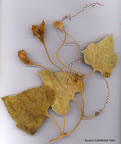| Cucurbitaceae |
 Cucurbita mosehta |
|
| CUCURBITA L. Trailing or climbing'or (some cultivars) short-stemmed prostrate herbs. Tendrils 3-7-branched, or, in short-stemmed cultivars, much reduced or absent. Flowers large, solitary, yellow, monoecious, Hypanthium campanulate. Corolla distinctly gamopetalous. Stamens with anthers united into an oblong head; connectives rather narrow; anther-thecae flexuous. Fruits often large, firm-walled, fleshy, indehiscent, very variable in size, shape, ornamentation and colour. Seeds elliptic in outline, smooth, compressed, bordered. Five species, all natives of the New World, are widely cultivated, of which three are recorded from Turkey. C. pepo L. is by far the most important; C. maxima Lam. is met with less frequently; C. moschata (Lam.) Poiret only occasionally. The fruits are the gourds, vegetable marrows and pumpkins of commerce (in Turkish, 'kabak"). For details see Zhukovsky, 526-528, f. 273-277 & Pangalo in Zhukovsky, 543-548, t. 10. 1. Fruit-stalk hard, angled, not inflated or corky; flowers not fragrant 2. Plant prickly-setose; fruit-stalk not or little expanded at attachment to fruit; seeds with well-defined rounded margins; sepals lanceolate-subulate C. pepo 2. Plant rather softly hispid; fruit-stalk markedly expanded at attachment to fruit; seeds with thin wavy or ragged, often hyaline, margins; sepals strap-shaped, parallel-sided, or with expanded tips C. moschata 1. Fruit-stalk rather soft, not angled, inflated and corky; flowers faintly fragrant C. maxima |